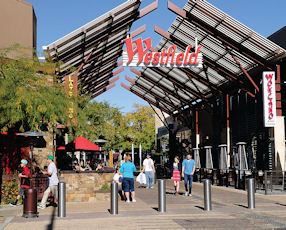The mall just isn’t the same. In the 1980s, the Sherman Oaks Galleria was the epicenter of the enclosed shopping mall world and the Valley Girls that strolled them. But recent rehabs have changed the character of many of the region’s top shopping centers. Just a few years ago big box retailers were taking the place of aging department stores, and while some new Targets and Wal-marts are still being built, the trend has shifted toward repurposing and expansions that leave more open space and create a pedestrian town-square feel. Take the Valencia Town Center. Once a traditional enclosed mall, Westfield LLC, the Sydney mall developer with U.S. offices in Culver City, has transformed the regional mall with its addition of several hundred thousand square feet of space dubbed The Patios. The area has outdoor seating and gathering areas, fire pits lit up at night and a children’s play space. And shoppers are responding well, according to Stacie House, marketing director for the mall. “The (Patios) offers a significant opportunity for the community to engage with and enjoy the Santa Clarita lifestyle,” she said. The Patios isn’t alone. Of the top 10 on this year’s Business Journal list of largest shopping centers, ranked by gross leasable area, seven were rehabbed during the recession. Property managers say the expensive makeovers are finally paying dividends. Stores are bouncing back from Internet shopping competition and the recession, and many are looking to take new leases. “We were under construction for most of the recession,” said Jennifer Ciccone, senior property manager at The Oaks in Thousand Oaks, owned by Santa Monica mall developer Macerich Co. “But now, coming out of the recession, we’re really well positioned and we’re seeing an uptick in both interest and leases.” The main mall building at Valencia is 100 percent occupied, and The Oaks has just a 3 percent vacancy, according to real estate data provider CoStar Group Inc. Despite a rough few years as shoppers cut back on expenses, the rehabs were the right thing to do and in-line with the national development trend, say industry experts. Jesse Tron, a spokesman for the International Council of Shopping Centers, a New York-based trade group, said malls that have undergone a facelift are seeing the reward in lower vacancies and higher foot-traffic. “We’re really seeing the vacancy rates come down to numbers they haven’t seen in years,” he said. “It’s still a little bit of a struggle at the smaller and older centers, but the high-end properties are really looking good.” Chain stores are showing signs of sales growth too – 4.2 percent in February at large retail stores like Gap – and the renovated spaces are filling up as companies once again think about brick-and-mortar expansion. But Tron said that mall owners are not done with their makeovers. With the decline of some big box retailers, mall owners are continuing to develop more patio space. “If they lost an anchor tenant and couldn’t find a new one or subdivide it, they’ve torn it down and made patio space on the existing pad,” he said. Another Westfield property, the Topanga mall in Woodland Hills, is one example. It has done some building on land that was previously parking lots or smaller anchor pads. The expansion – a mere fraction for what it has planned for coming years at the mall – has moved the property to the top of the Business Journal’s list, with 1,578,567 square feet of leasable space. Mobile shopping Nearly as much as the recession, the rise in Internet shopping was a blow to Valley retailers in recent years. “The industry really got hit on two fronts, with Internet shopping on the rise and the recession,” said Tron. “Some key retailers closed up shop when they couldn’t handle the competition.” But now, the tide seems to have balanced out, and centers are working to capture a reverse trend – online stores looking for brick and mortar establishments. “There really has to be a balance between the two, and quite a few stores that began as online-only are looking for physical locations,” he said. During the holiday season, Microsoft Corp. announced that it would begin experimenting with 34 mall locations in a bid to counter rival Apple Inc.’s huge shopping center presence. The Bellevue, Wash. software giant opened one of those locations in the Glendale Galleria. Mall operators say they are now trying to integrate online shopping with in-store visits. At the Oaks, a new mobile app drives shoppers to retailers’ sites and promotes center events. “We implemented the app last year,” said Ciccone, the property manager. “It’s something that we rolled out around the company at other malls. It’s been really well received by the retailers.” The app promotes in-store sales, directs shoppers to retailer’s individual mobile apps and websites, and even helps shoppers remember where they parked. Tron, the industry spokesman, said mobile features are critical as shopping centers work to lure shoppers to make the trip. “The Internet didn’t kill the malls,” he said. “But now, having a multi-channel way to access shoppers is almost required for shopping centers. And that’s not going away.”
